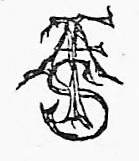Introduction

Frederick Sandys (1832–1904) is widely regarded as one of the outstanding illustrators of the mid-nineteenth century. Though never a popular artist in the manner of J.E. Millais or George Cruikshank, his wood-engravings in black and white were seen by a large and appreciative audience. Published in The Cornhill Magazine, The Quiver, Once a Week and Good Words, his illustrations’ reputation was enhanced by their setting among other masterworks of the period. But Sandys was primarily ‘an artist’s artist’. His standing among his peers was unassailable; George du Maurier notes how he ‘burst on the black and white world like a meteor’ (Social Pictorial Satire, p.11), and D. G. Rossetti described him as the greatest draughtsman of the age (Reid, p.55).
At the end of the century his reputation was further enhanced by the sympathetic studies of Esther Wood (1896) and Percy Bate (1904), and modern commentators have continued in the same tradition. Forrest Reid’s evaluation is typical (1928), noting how Sandys produced some of the ‘most important’ work of the time (p.55). This judgment is echoed by Gregory Suriano (2000), who describes the designer as ‘everyone’s favourite’ artist of ‘The Sixties’ (p.200), and parallel remarks appear in the studies of Paul Goldman (1996, 2004) and Gordon Ray (1976).
Characterising his achievement is nevertheless a problematic task. Sandys’s graphic art is complex and unpredictable; multi-layered and driven by an intensely individual approach that combines visionary single-mindedness with technical diligence, it resists easy categorizations. The following sections explore the main features of his subjects, styles, themes, and influences. — Simon Cooke
Critical discussions


Theme, motif, and subject
Illustrations
- Life's Journey by George Wither
- The Little Mourner by Alford
- The Nightmare (parody of Millais's A Dream of the Past -- Sir Isumbras at the Ford)
- Amor Mundi by Christina Rossetti
- The Death of King Warwolf
- Harold Harfargr by George Borrow
- Danaë in the Brazen Chamber by A. C. Swinburne
- Until Her Death
- The Waiting Time
- If he would come to-day
- The Old Chartist
- Sleep
- From my Window
- Cleopatra
- Rosamund
- The Three Statues of Aegina
- The Legend of the Portent
- Helen and Cassandra
- Jacob hears the voice of the Lord
- Manoli
- The Advent of Winter
- The Boy Martyr
- Jacques de Caumont
- The King at the Gate
- The Sailor’s Bride
- Yet once more on the organ play
- Bhanavar the Beautiful



Miscellaneous
Work in other media and genres
Last modified 18 July 2013